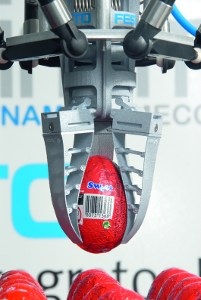 |
| August 07, 2012 | Volume 08 Issue 29 |
Designfax weekly eMagazine
Archives
Partners
Manufacturing Center
Product Spotlight
Modern Applications News
Metalworking Ideas For
Today's Job Shops
Tooling and Production
Strategies for large
metalworking plants
Engineer's Toolbox:
Adaptive gripper design inspired by nature sorts bulbs and chocolate eggs

Festo's gentle adaptive gripper DHDG has fingers that fully enclose delicate objects like chocolate eggs without crushing them. [Photo: Festo]
Try gripping tulip bulbs and chocolate eggs with conventional metal grippers or vacuum functions, and you'll probably end up with a fair amount of loss and damage. Speed and quality, two central objectives of automation technology, are thrown out the door - along with your squished flower bulbs and mucked-up chocolate. But there is another way.
Festo's super-clever bionic adaptive gripper, called DHDG, is light and flexible. It consists of a pneumatic actuator in the form of a bellows and three gripper fingers arranged in the Fin Ray pattern of the tail fin of a fish. The basic structure of each gripper finger is made of two flexible bands that meet at one end to form a triangle (see video 2 for more on how the gripper is made). Intermediate stays are connected to the bands at regular intervals by articulated joints. This flexible design enables the gripper fingers to adapt to the shape of a workpiece when pressure is applied laterally - just like a human hand, but much faster.
Sorting chocolate eggs
This bionic gripper operates on the same principle when used in a sorting station for chocolate eggs. The gripper fingers fully enclose the chocolate eggs without crushing them or damaging the foil wrapping. "The flexible design of the adaptive gripper DHDG even allows the chocolate eggs to be gripped if they are leaning to one side or are incorrectly positioned," says engineer Federico Nardone of the Italian system integrator FluidoDinamica.
The proportional pneumatic valve VPPM ensures that the pressure is correct; this allows individual acceleration and pressure ramps to be applied. The variable flow rates provided by these proportional valves allow the cylinder pressures to be adapted to a given production or sorting process. Everything is connected to the robotic controller CMXR, which controls the Tripod robotic handling unit. The Tripod moves the adaptive gripper DHDG quickly toward the chocolate eggs. "This type of robot is ideal for handling light loads at high speeds," says Nardone.
90% lighter
The adaptive gripper DHDG is manufactured using selective laser sintering. In this process, successive layers of polyamide powder of a thickness of just 0.1 mm are applied and allowed to harden to form a solid component. This reduces the weight acting on the tool carrier by no less than 90% compared with a conventional metal gripper. This means that the adaptive gripper DHDG is able to grip and transport workpieces in a very energy-efficient way.
Gripping bulbs
The advantages of these lightweight and adaptive bionic grippers are also exploited by Total Systems, a Dutch company producing machines and systems for handling flowers and bulbs. The adaptive gripper DHDG became available at just the right time when the company was developing a new machine for sorting bulbs. Total Systems uses the gripper to sort the bulbs according to size and quality. The adaptive gripper now carries out the work that was previously done laboriously and less efficiently by human hands.
Source: Festo
Published August 2012
Rate this article
View our terms of use and privacy policy
